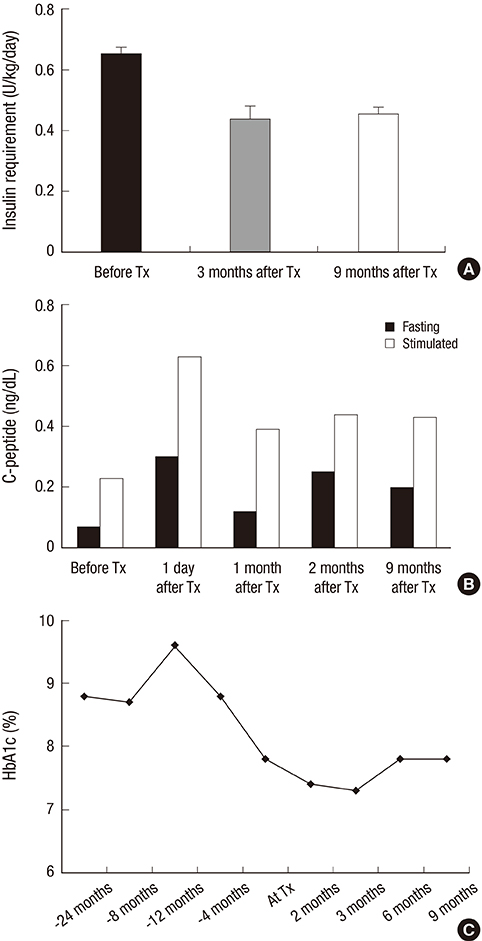J Korean Med Sci.
2015 Jul;30(7):991-994. 10.3346/jkms.2015.30.7.991.
Reversal of Hypoglycemia Unawareness with a Single-donor, Marginal Dose Allogeneic Islet Transplantation in Korea: A Case Report
- Affiliations
-
- 1Division of Endocrinology and Metabolism, Department of Internal Medicine, Seoul St. Mary's Hospital, The Catholic University of Korea, Seoul, Korea. yoonk@catholic.ac.kr
- 2Department of Surgery, Seoul St. Mary's Hospital, The Catholic University of Korea, Seoul, Korea.
- 3Department of Radiology, Seoul St. Mary's Hospital, The Catholic University of Korea, Seoul, Korea.
- KMID: 2164488
- DOI: http://doi.org/10.3346/jkms.2015.30.7.991
Abstract
- Pancreatic islet transplantation is a physiologically advantageous and minimally invasive procedure for the treatment of type 1 diabetes mellitus. Here, we describe the first reported case of successful allogeneic islet transplantation alone, using single-donor, marginal-dose islets in a Korean patient. A 59-yr-old patient with type 1 diabetes mellitus, who suffered from recurrent severe hypoglycemia, received 4,163 islet equivalents/kg from a single brain-death donor. Isolated islets were infused intraportally without any complications. The immunosuppressive regimen was based on the Edmonton protocol, but the maintenance dosage was reduced because of mucositis and leukopenia. Although insulin independence was not achieved, the patient showed stabilized blood glucose concentration, reduced insulin dosage and reversal of hypoglycemic unawareness, even with marginal dose of islets and reduced immunosuppressant. Islet transplantation may successfully improve endogenous insulin production and glycemic stability in subjects with type 1 diabetes mellitus.
MeSH Terms
-
Blood Glucose/analysis
Diabetes Mellitus, Type 1/*surgery
Female
Humans
Hypoglycemia/*surgery
Immunosuppression/methods
Immunosuppressive Agents/therapeutic use
Islets of Langerhans/physiology/*surgery
Islets of Langerhans Transplantation/*methods
Middle Aged
Republic of Korea
Tissue Donors
Blood Glucose
Immunosuppressive Agents
Figure
Cited by 1 articles
-
Management of Hypoglycemic Unawareness and the Current Status of Clinical Allogeneic Islet Transplantation
Sang-Man Jin
J Korean Diabetes. 2016;17(1):6-10. doi: 10.4093/jkd.2016.17.1.6.
Reference
-
1. Shapiro AM, Ricordi C, Hering BJ, Auchincloss H, Lindblad R, Robertson RP, Secchi A, Brendel MD, Berney T, Brennan DC, et al. International trial of the Edmonton protocol for islet transplantation. N Engl J Med. 2006; 355:1318–1330.2. Goss JA, Schock AP, Brunicardi FC, Goodpastor SE, Garber AJ, Soltes G, Barth M, Froud T, Alejandro R, Ricordi C. Achievement of insulin independence in three consecutive type-1 diabetic patients via pancreatic islet transplantation using islets isolated at a remote islet isolation center. Transplantation. 2002; 74:1761–1766.3. Yang TY, Oh SH, Jeong IK, Seo IA, Oh EY, Kim SJ, Chung JH, Min YK, Lee MS, Lee MK, et al. First human trial of pancreatic islet allo-transplantation in Korea--focus on re-transplantation. Diabetes Res Clin Pract. 2002; 56:107–113.4. Lee BW, Jee JH, Heo JS, Choi SH, Jang KT, Noh JH, Jeong IK, Oh SH, Ahn YR, Chae HY, et al. The favorable outcome of human islet transplantation in Korea: experiences of 10 autologous transplantations. Transplantation. 2005; 79:1568–1574.5. Shapiro AM, Lakey JR, Ryan EA, Korbutt GS, Toth E, Warnock GL, Kneteman NM, Rajotte RV. Islet transplantation in seven patients with type 1 diabetes mellitus using a glucocorticoid-free immunosuppressive regimen. N Engl J Med. 2000; 343:230–238.6. Hill NR, Hindmarsh PC, Stevens RJ, Stratton IM, Levy JC, Matthews DR. A method for assessing quality of control from glucose profiles. Diabet Med. 2007; 24:753–758.7. Park SA, Ko SH, Lee SH, Cho JH, Moon SD, Jang SA, Song KH, Son HS, Yoon KH, Cha BY, et al. Average daily risk range-index of glycemic variability-related factor in type 2 diabetic inpatients. Korean Diabetes J. 2009; 33:31–39.8. Kovatchev BP, Otto E, Cox D, Gonder-Frederick L, Clarke W. Evaluation of a new measure of blood glucose variability in diabetes. Diabetes Care. 2006; 29:2433–2438.9. The Collaborative Islet Transplant Registry (CITR). Seventh annual report. 2011. accessed on 23 January 2014. Available at http://www.citregistry.org/reports/reports.htm.10. Anazawa T, Matsumoto S, Yonekawa Y, Loganathan G, Wilhelm JJ, Soltani SM, Papas KK, Sutherland DE, Hering BJ, Balamurugan AN. Prediction of pancreatic tissue densities by an analytical test gradient system before purification maximizes human islet recovery for islet autotransplantation/allotransplantation. Transplantation. 2011; 91:508–514.11. Hering BJ, Kandaswamy R, Ansite JD, Eckman PM, Nakano M, Sawada T, Matsumoto I, Ihm SH, Zhang HJ, Parkey J, et al. Single-donor, marginal-dose islet transplantation in patients with type 1 diabetes. Jama. 2005; 293:830–835.
- Full Text Links
- Actions
-
Cited
- CITED
-
- Close
- Share
- Similar articles
-
- Reversal of Hypoglycemia Unawareness with a Single-donor, Marginal Dose Allogeneic Islet Transplantation in Korea: A Case Report
- History, current status and perspective of islet transplantation
- Clinical Allogeneic and Autologous Islet Cell Transplantation: Update
- Management of Hypoglycemic Unawareness and the Current Status of Clinical Allogeneic Islet Transplantation
- Is islet transplantation a realistic approach to curing diabetes?



